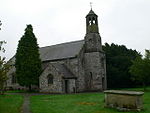The Clwydian Range and Dee Valley (Welsh: Bryniau Clwyd a Dyffryn Dyfrdwy) is a designated Area of Outstanding Natural Beauty (AONB) located in north-east Wales, covering the Clwydian Range (Welsh: Bryniau Clwyd), and the valley of the River Dee (Welsh: Afon Dyfrdwy).
Designated in 1985 as the Clwydian Range AONB, and expanded to its current form in 2011, the Area of Outstanding Natural Beauty includes: medieval field systems, open heather moorland, prehistoric hillforts, limestone crags, broad leaved woodland, wooded valleys, and farmland.
The AONB falls within the jurisdiction of the local authorities of Denbighshire, Flintshire, and Wrexham County Borough, with the majority, 80% of the AONB in Denbighshire, and the remaining 20% split evenly between the other two authorities. The AONB is the largest of only five AONBs in Wales, and one of the 46 in the United Kingdom. Additionally, it is one of only 8 protected areas of Wales. Long-distance footpaths; Offa's Dyke Path, and the Clwydian Way pass through the AONB. The area of the Clwydian Range and Dee Valley AONB is 390 km2 (150 sq mi), and has been proposed by the Welsh Government to be replaced by a North East Wales National Park, which would be Wales' fourth national park.
The AONB is underlain by sedimentary rocks dating from the Ordovician, Silurian, and early Carboniferous period with Triassic age rocks on lower slopes. The highest peak in the AONB is at Moel Fferna, peaking at 630 m (2,070 ft). The mainly Silurian Clwydian Range supports rounded, heather-clad hill tops which provide habitats for scarce flora and fauna and are home to Iron Age hillforts. Several areas have been designated as Sites of Special Scientific Interest and Special Areas of Conservation, with the AONB also home to multiple listed buildings, scheduled monuments, and part of the Pontcysyllte Aqueduct and Canal UNESCO World Heritage Site. In 2018, an estimated 1.1 million people visited six key sites across the AONB, generating approximately £24.1 million to the Welsh economy, according to Natural Resources Wales.
The earliest evidence of human occupation in the AONB is from stone tools dated between 30 and 40,000 years ago in caves near Tremeirchion, with the oldest human-made feature in the AONB being the mound, Gop Cairn. The area is now used for a range of recreational, tourism, and agricultural purposes.










